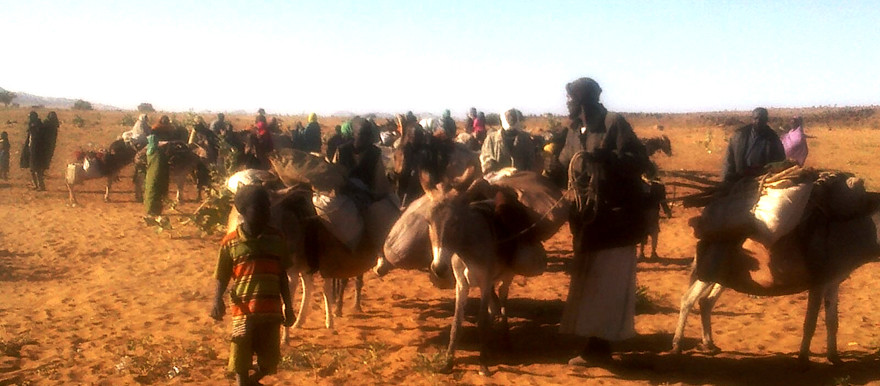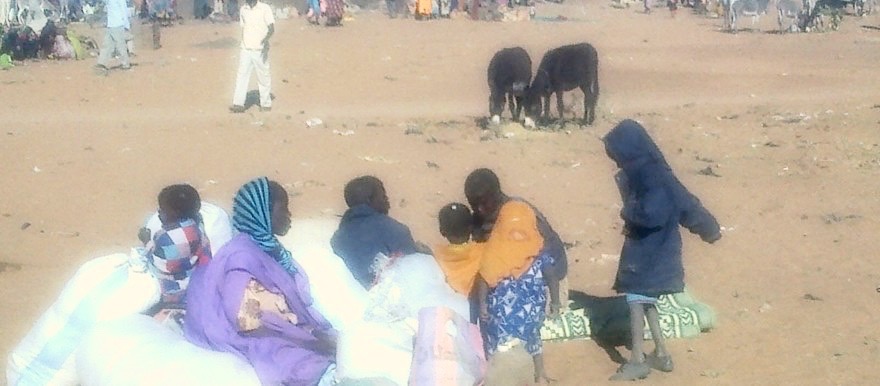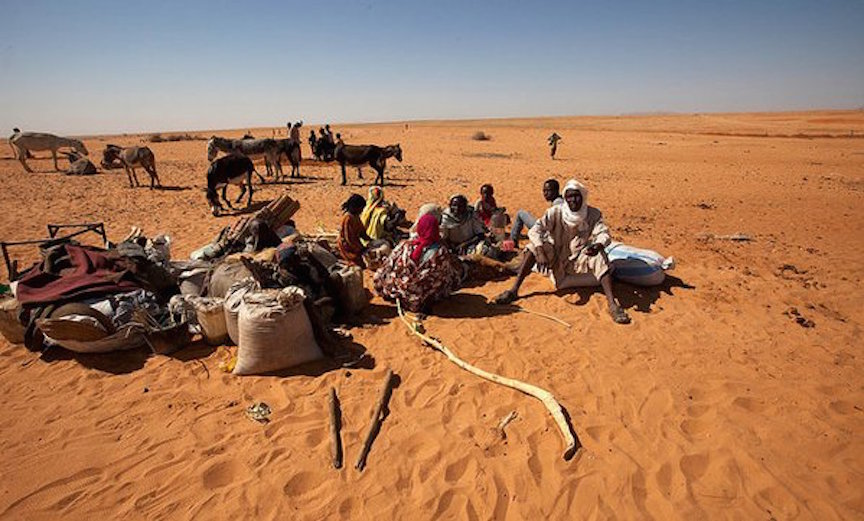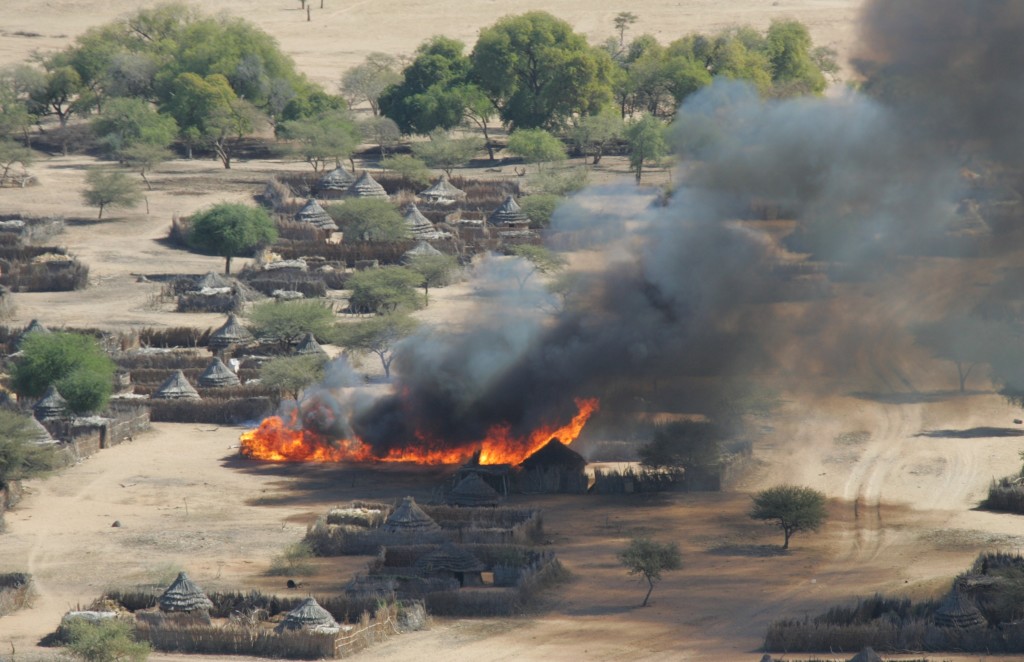“Vast carnage in Jebel Marra (Central Darfur) fails to spur the international community,” The Huffington Post, February 17, 2016 |
On February 11, 2016 the New York Times published my brief and summary account of the current crises in Darfur, most particularly the extension of Khartoum’s genocidal counter-insurgency campaign to the west—from “East Jebel Marra” in North Darfur to the Jebel Marra massif itself, in the very center of Darfur (the eastern tip of Jebel Marra juts far into North Darfur). Fighting today remains undiminished and some of the implications and consequences of this onslaught, which began in earnest in mid-January 2016, are already clear.
[A scalable map of Jebel Marra can be found here]
UN figures suggest that many tens of thousands of people—overwhelmingly children and women—have already been displaced, many to harsh areas with little or no humanitarian relief capacity. Some 40,000 have fled to East Jebel Marra, the site of so much genocidal violence over the past three years. Others have fled west and south. Radio Dabanga (see below) reports that by the third week of January, “At least 60,000 people from 40 villages around Soreng in Rokoro locality in Central Darfur, fled their homes.” The UN reports that altogether almost 50,000 civilians were displaced in January alone. We may be certain certain that well over 100,000 civilians will have been displaced by spring planting season, and thus unable to grow critically needed food.
Recent photograph of civilians fleeing the violence in Jebel Marra (photography by Radio Dabanga correspondent)
They flee their villages as they come under constant aerial bombardment and suffer the scorched-earth tactics that have defined conflict in Darfur since 2003. The National Islamic Front/National Congress party in regime has determined that this dry (fighting) season will be the last in its Darfur counter-insurgency. The regular Sudan Armed Forces and the regime’s primary Arab militia force (the Rapid Support Forces, or RSF—a “new Janjaweed) are utterly unconstrained, having been given orders by regime Second Vice President Hassabo Mohamed Abdel Rahman to leave none of the African tribal populations alive in this part of Darfur.
What do the consequences of this onslaught look like? What happens when the regime carries out its massive attack on the African populations likened by Hassabo to “insects”? I have written extensively about recent violence in East Jebel Marra, and we may be sure that the nature of the attacks I chronicled there is unchanged: large numbers of girls and women are raped; farms and foodstocks are destroyed; livestock are looted or killed; whole villages are burned to the ground; men and boys are murdered without mercy.
Displaced persons with no humanitarian relief; these are the people Second Vice President Hassabo Mohamed Abdel Rahman referred to as “insects” (photograph by Radio Dabanga correspondent)
Because Khartoum allows no journalists or human rights reporters into areas of fighting in Darfur, and because humanitarian access to Jebel Marra has so long also been denied by Khartoum (as has access for UN/African Union “peacekeepers”), we must gather our news from sources in the Darfuri diaspora, most prominently the remarkable Dutch-based news organization Radio Dabanga. Just a few of the recent headlines from this daily news source must compel us to ask why the UN, or the international community independently of the UN, does not compel humanitarian access. Some of the dispatch titles speak for themselves, but I have excerpted a few key sentences from some:
• January 15, 2016, Civilian casualties by heavy fighting in Darfur’s Jebel Marra
Aerial bombardments, long-range artillery, and heavy weapons were used during the attacks on villages in Jebel Marra: Leiba, Niama, Kara, and adjacent settlements. A still unknown number of civilians were killed by bombs or shelling. Hundreds of villagers have scattered and taken shelter higher up in the mountains, a witness informed Radio Dabanga. “Their humanitarian and health situation is dire,” he explained on the phone.
• February 11, 2016, ‘Tens of thousands trapped in Darfur’s Jebel Marra’
• February 12, 2016, Bombing kills baby, influx of displaced into North Darfur
• February 5, 2016, Children starve high in Darfur’s Jebel Marra
Eleven children reportedly died of malnutrition while taking shelter in one of the highest peaks in Jebel Marra, at the end of January. Three women died at childbirth. Returning militiamen spark fear among residents in western Jebel Marra.
• February 10, 2016, ‘Sudan air raids target displaced, block trade in Jebel Marra’
• January 24, 2016, Darfur: Strafing continues in Jebel Marra war zone
About 100 villages west of Golo and south of Kotoronek have been abandoned too, multiple sources reported from the western part of Mount Marra. They could not give more information because “moving around is too risky because of the continuous bombing and shelling,” one of them said. They reported that the majority of the villagers fled high into the mountain, “where they must be suffering dire humanitarian conditions.” The sources said that all the roads to the mountain are still blocked. “The markets and shops are closed, so no one can buy flour or sugar,” a resident of Golo noted.
• January 24, 2016, 520 displaced families reach Tawila in North Darfur
• January 24, 2016, More Central Darfur villagers displaced by bombing
• January 22, 2016, Darfur: Militia attacks, burned villages in Jebel Marra offensive
• January 26, 2016, Children killed in bombardment on Jebel Marra, Darfur
Three children were killed and five others were wounded following aerial bombardments on villages in Darfur’s western Jebel Marra on Monday morning. The area of Golo, in the upper part of Central Darfur, has been under attack by the Sudanese Air Force since Saturday.
• February 1, 2016, Six die in bombardment near Golo in Darfur’s Jebel Marra
Flight in the harsh landscape of Darfur can be deadly (photograph by Radio Dabanga correspondent)
These are but a few snapshots of the suffering and destruction that has gone largely unreported by international news agencies, excepting chiefly Agence France-Presse (AFP) and those who have picked up AFP’s two dispatches.
The UN in New York has been especially tepid, as have Western governments; this sends a clear signal to Khartoum that it can continue with genocidal counter-insurgency warfare without paying a significant price. It is a signal that has been sent continuously for over a decade, as countless UN resolutions are flouted, UN/AU peacekeepers with Chapter 7 authority are abused, obstructed, and murdered, and humanitarian access is entirely at the discretion of a regime notorious for using the manipulation of relief aid as a weapon of war.
The many tens of thousands of newly displaced persons add to Darfur’s grim totals: 2.7 internally displaced persons, some 380,000 Darfuri refugees in eastern Chad, and more than 500,000 dead from the and direct and indirect consequences of thirteen years of intense, ethnically-targeted violence in the region.
Ethnically-targeted violence has never fully abated in Darfur, and reports to the contrary have worked to eclipse the ongoing suffering and destruction of the African tribal groups of Darfur. This photograph was taken by Brian Steidle in 2005; the previous year, a memorandum from the headquarters of notorious Janjaweed leader Musa Hilal (Miseriya, North Darfur) had distilled the intentions of Khartoum’s counter-insurgency effort: “Empty the region of African tribes; change the demography of Darfur.” The change in the demography continues with Khartoum’s Jebel Marra offensive
Far from having “decisively cooled,” as the New York Times reported four years ago, Darfur is in the midst of some of the greatest violence we have seen in a decade. AFP (February 7, 2016) reports the UN Resident and Humanitarian Coordinator in Sudan as declaring:
“[The displaced of Jebel Marra] are basically in need of everything.” The surge in violence “has seen, as a result, the worst civilian displacement that we have seen in the UN in the past decade” in the Jebel Marra area, where there were also heavy clashes in previous years, she said. (emphasis added)
An inevitably invidious but necessary comparison with Syria forces a difficult question on Western governments and news organizations: Why are you essentially ignoring a catastrophe that on any human or humanitarian scale must be seen as comparable to that in Syria? None of the answers speaks well of how policy and news attention is apportioned.
[Eric Reeves, a professor at Smith College, has published extensively on Sudan, nationally and internationally, for the past seventeen years. He is author of Compromising with Evil: An archival history of greater Sudan, 2007 – 2012 (September 2012)]



